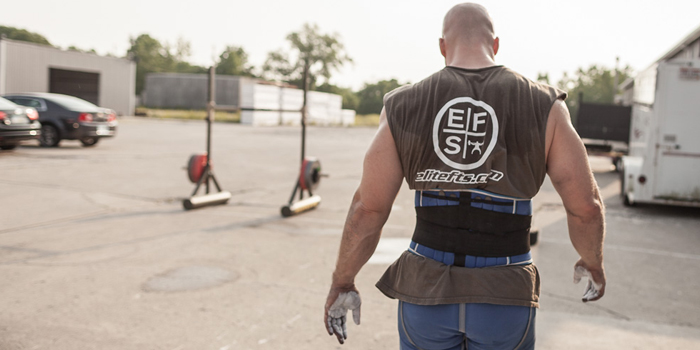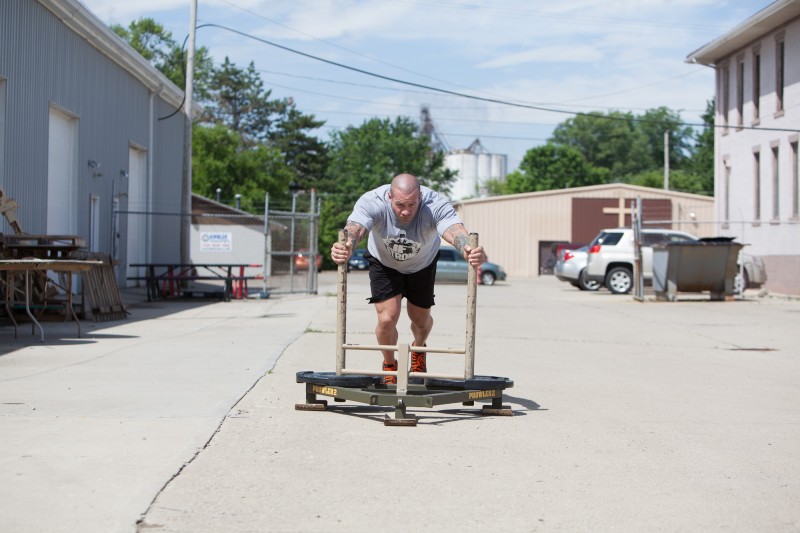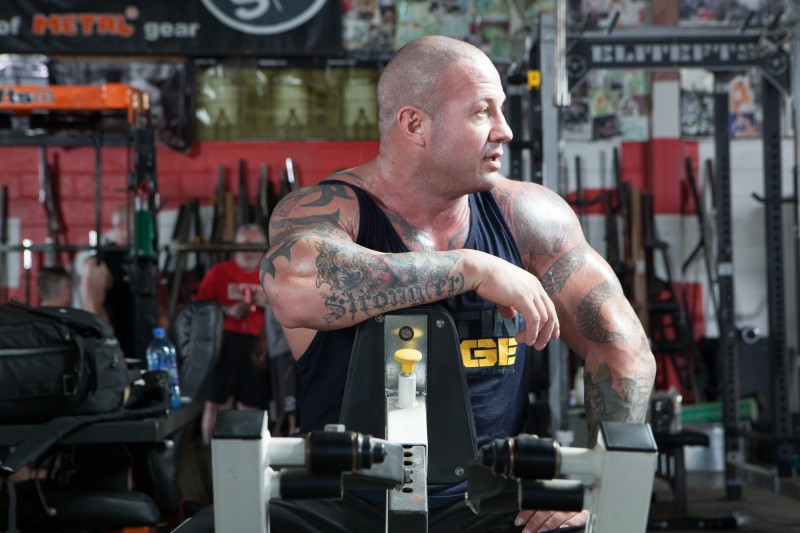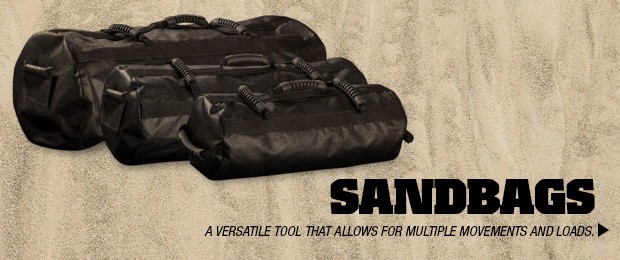
When looking to write a program for strongman, the task can seem daunting. Strongman is a sport with almost unlimited combinations of events and disciplines. Some contests can be extremely heavy and static, while others can be more dynamic and require a high level of skill for certain events. How do we develop an athlete to be able to jump into a contest at any time and be an all-around athlete ready for the task at hand?
Finding Strength: Tyson's Playground
First, we need to look at all the qualities required of a well-rounded strongman. In order to perform satisfactorily in a contest, you must be strong, explosive, agile, have solid technique, and be able to recover quickly between events. Training for a contest, or the sport in general, requires the ability to cover all of these things within a training block and being able to keep them all at a relative level where none lag behind the others. When setting up a program for strongman, I like to do it the same way I would for any other athlete. The first thing we’re going to approach is agility and speed.
Agility and Speed
How do we incorporate agility and speed into a program? We need to train these things first so we are not fatigued from other exercises. Learning new patterns or foot placements when under fatigue will diminish the return. Footwork, learning how to change levels, and work for acceleration and deceleration are important for transitions between implements in a medley, running to a stone in a series, and even when running a yoke or farmers walks. They can be trained in a variety of ways. For performance prep, I will personally do running warm-up drills like high knees, A skips, B skips, and a variety of others. Additionally, things like cone drills and small hurdle work are great options. If your feet are completely awful, agility ladders may be helpful up to a point, but I wouldn’t rely on them as your main staple.
In the program below, I’ve added three-cone drills, which help with things like deceleration, acceleration, and changing levels with your hips. These skills are useful in things like suicide medleys, where you will be sprinting back and forth, picking things up from the ground. The hurdles, both forward and lateral jumping, help with landing when jumping in different directions. Think about running or jumping down from a power stairs run, or in and out of a frame in a carry medley.
Now that we’ve covered agility, let’s work on speed. Developing speed can mean a variety of different things. Are you terrible at sprints? Do you need to develop faster hips for things like stone loads? This is where some tough self-assessment comes in. Heavy Prowler sprints and box jumps can be great tools to train speed after performance prep. You can even take this time to train your footwork with farmers walks and yoke runs, assessing how far you need to run, and in what time frame you need to do it. For instance, if you go back and look at some of the fastest yoke runs in previous contests, you might see that the best average speeds were about one and a half to two seconds per 10 feet. Load up a yoke to a weight that you can match that speed and go for a few runs. Remember, when building speed with sprints and other variations, we need to be able to exert maximum effort for each set, which means coming to almost full recovery between sets.
MORE: Training Triple Extension — Olympic Lifting Variations and Substitutions
Things like box jumps and overhead throws, like I’ve added to the program below, are great for learning how to transfer power from the hips and help work on triple extension. These have great carryover to push pressing a log, axle, or loading a stone. One of the biggest mistakes I see with overhead or loading events is not being able to hit true triple extension.
Strength
The next thing we need to look at is strength. Obviously, it’s strongman — you need to be strong. This is where most of the meat and potatoes will be, and if you’re competitive, you’ve already learned a great deal about how to train for this. However, for the sake of thoroughness, let’s cover it. During the week, assuming you’re going to be doing an event day on the weekends like most strongman crews do, we’re going to be training mostly like a powerlifter. This is where I like to stick most of my squatting, benching, strict overhead work, and sometimes a deadlift variation, depending on the contest the athlete is getting ready for. My philosophy on how to approach the strength portion was nicely put by elitefts teammate Matt Mills: “Train the main movement like a powerlifter, accessories like a bodybuilder, and condition like a strongman.”
I like to train heavy deadlifts outside of event days. In the sample week, I have them on day one of the program. I like to hit a heavy deadlift during weekly training, and then depending on what event is coming up in a show, I will work on technique and volume during event days. Bench and overhead can be switched back and forth for the main movement on upper days, but that is all dependent on your strengths.
Conditioning
This leads us to our next element in developing a program: conditioning. A large portion of strongman competition has its mainstay in the anaerobic lactic, or glycolytic, energy system (AKA hating your life for 60 seconds). In order to be able to grind through those last few reps in a car deadlift, or finish a suicide medley, you’re going to have to be able to outlast your competition. Strength will only go so far in these events. Training for this sort of conditioning can be intense and grueling, but it can also be done quickly. Doing high-intensity interval training, like Prowler work for a duration of 30 to 60 seconds for rounds, can be an easy way to train this. While it may seem logical to train the event you have coming up in this range, I would focus on things like the Prowler because you can train the same energy system without the brutality of a lot of strongman movements, saving your joints. I also like to start off with a low frequency in the beginning of a training cycle and focus more on developing your cardio, which I have listed three times a week below, rather than two times a week for conditioning.
Cardio is a scary word for a lot of strongmen and women, but it is very necessary. I hate to be the bearer of bad news, but doing 10 reps of deadlift isn’t cardio. Building your aerobic base in the beginning of a training cycle will reward you down the line with better recovery between sets, enabling you to do more overall work and giving you the ability to do longer intervals in conditioning. It may even help with recovery. Something as simple as walking at a fast pace on a treadmill three to four times a week is really all you need. It isn’t glamorous, but it is worth it.
Putting It Together — The Program
Now that we’ve covered all of the necessary parts of a successful program, how do we put it all together? Below, I’ve outlined a sample week to give you a better idea of how you can put together a program that incorporates these principles.
Day 1 — Agility/Speed/Strength
Performance Prep:
- High Knees
- A Skips
- B Skips
- Walking High Kicks
Agility: Three-Cone Drill
Speed Work: Box Jumps, 4x1, 90% of max height
Strength: 18-Inch Deadlift, Work up to heavy set of three
Accessories:
- Front Squats: Heavy 5x5
- Reverse Hypers: 4x10
- Bulgarian Split Squats: 4x10 per leg
30 Minutes Cardio (Morning or post training)
Day 2 — Conditioning
Prowler Sprints: 10 rounds, 1:1 work to rest ratio (e.g. 60 seconds on, 60 seconds off)
Day 3 — Agility/Speed/Strength
Performance Prep:
Agility: Low hurdle work; lateral jumping/forward jumping
Speed Work: Overhead throwing work
Strength: Bench Press, Work up to heavy set of three
Accessories:
- Strict Overhead Press: Heavy 8x3
- Lat Pulldowns: Heavy 4x10
- Landmine Rows: Heavy 4x10
- Triceps Variation
30 Minutes Cardio (Morning or post training)
Day 4 — Conditioning
Prowler Sprints: 10 rounds, 1:1 work to rest ratio (e.g. 60 seconds on, 60 seconds off)
Day 5 — Rest
Day 6 — Events
This will be based on whether or not you train with a crew, but here’s a good example to round everything off:
- Heavy Log
- Heavy Deadlift Variation
- Moving Event
- Atlas Stones or Heavy Loading Event
- 30 Minutes Cardio (Post Events)
Day 7 — Rest
The program I’ve outlined above is similar to one I have used in the past while in competitive phases. Obviously, numbers for loads on heavy main movements will be based on your own strength levels, but the way this is set up will give you the ability to work in a classic linear periodization structure or tweak it to get it closer to a conjugate style (which I prefer). You’ll notice as you start to incorporate this style of training, you will feel more “ready” to attack your heavier main movements.
I realize that when you’re training with a strongman crew, which seems to be the majority of people, you’re usually at the mercy of whatever the crew is training that day. I will usually program my following week based on what the events were that day since the two days before an events days is allotted for conditioning and rest.
I hope this helps you begin your path to figuring out how to program for such a dynamic sport with so many variables. Being able to be self-aware, assess, and reassess while having an outline to guide you will help you continue to make progress over a very long time. Good luck and please don’t hesitate to ask questions!













@antiklondermiddel I rest on my rest days. Recovery is just as important as training.